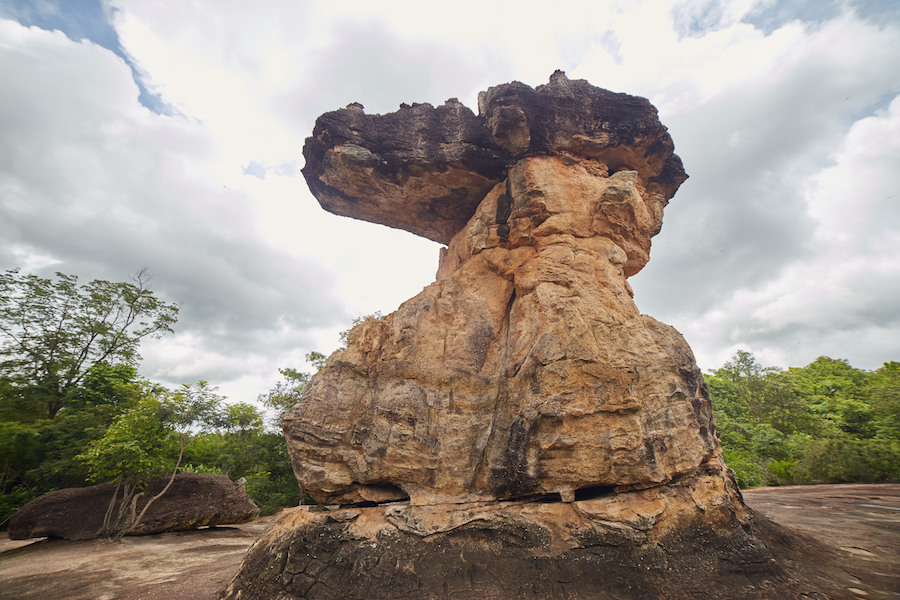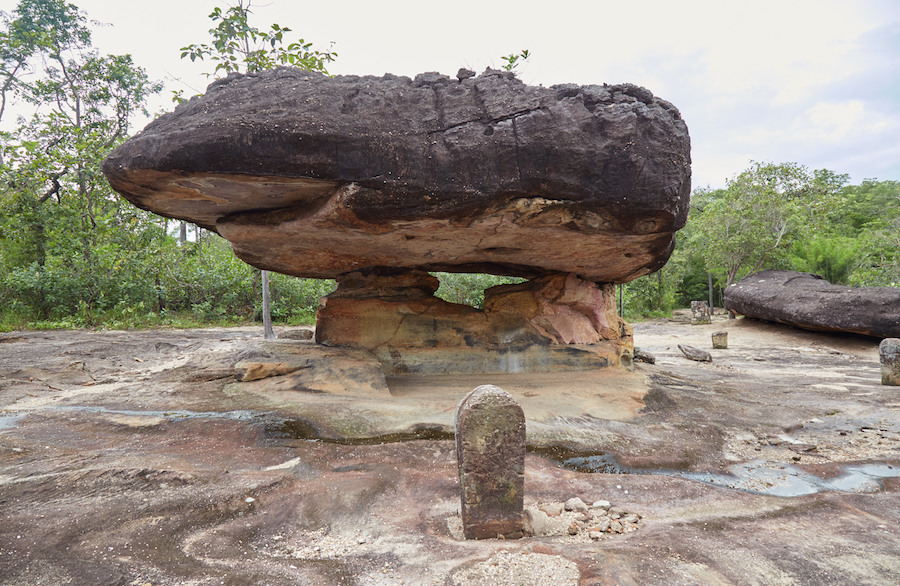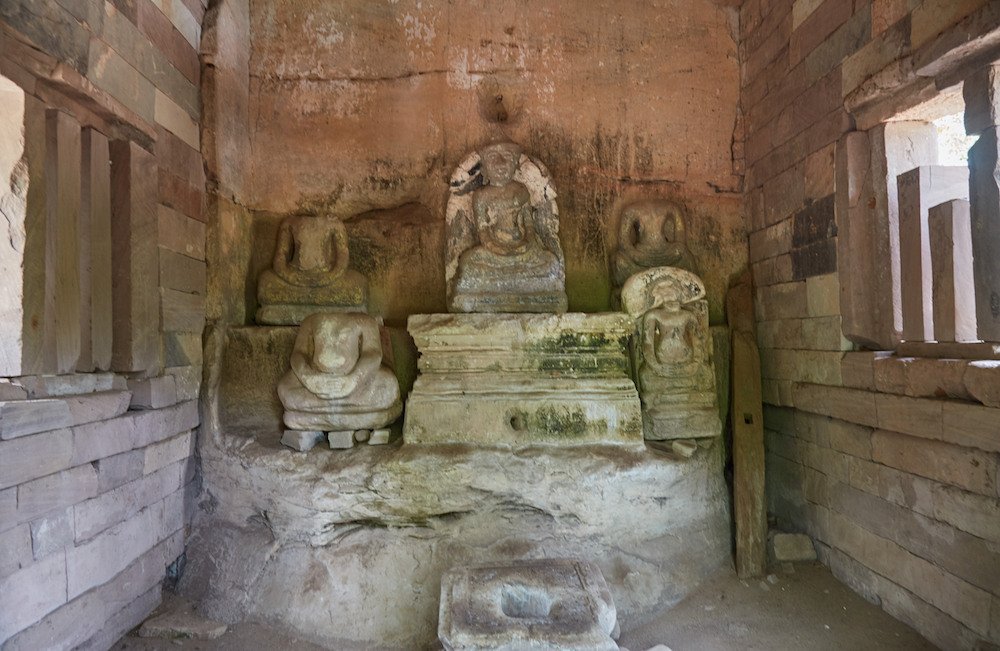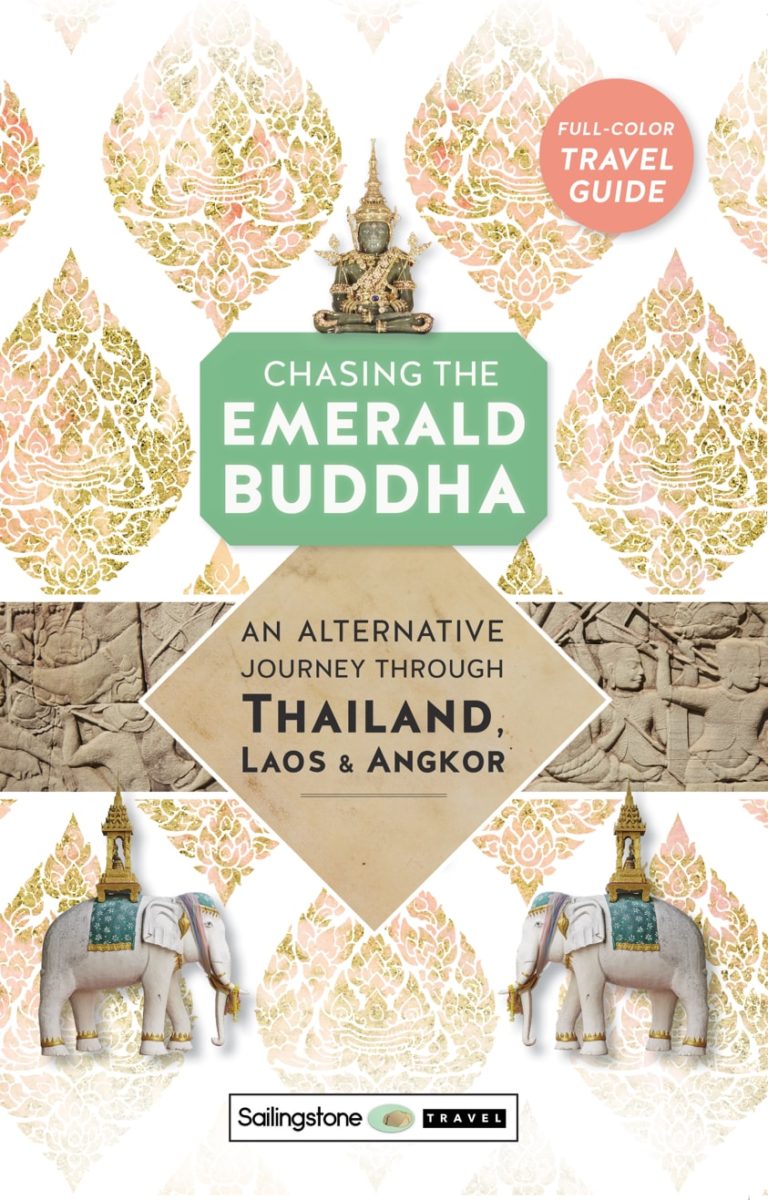Last Updated on: 27th January 2020, 11:49 am
As I began my walk along the rocky trail, I couldn’t hear anything but the sounds of the birds. It had been a long journey to get here, requiring both a shared and private taxi through small-town Udon Thani province. Arriving at the Phu Phra Bat Historical Park, I was surprised to encounter such a modern visitor information center, and an even fancier bathroom. But those already felt like a distant dream. I was now completely alone, surrounded by the forest and some gravity-defying rock formations which seemed to belong to another world.
Despite being mostly empty and desolate now, the area which makes up the park was inhabited continuously for thousands of years. As far back as the Neolithic era, hunger-gatherer communities took shelter in these mushroom-shaped rocks, leaving behind cave paintings which remain strikingly clear to this day. Their descendants are also believed to have lived at the site throughout the bronze age and beyond. More recently, the Mon Kingdom of Dvaravati left their mark in the form of carved Buddha images, small temples, and mysterious stone pillars. And after them came the Khmer.
The name Phu Phra Bat refers to footprints supposedly left by the Buddha himself thousands of years ago. But if you’ve spent enough time in Southeast Asia, places claiming to have Buddha’s footprints seem to be just about everywhere. The park, though, is also the setting of another famous local legend, from where most of Phu Phra Bat’s otherworldly rock formations derive their names.

The Legend of Nang Usa
Many of the rocks in the area are named after the legend of Nang Usa, but this piece of folklore doesn’t attempt to explain the origin of the bizarre landscape. Instead, it takes place long after humans have discovered the place. And unlike most local legends in Asia, there are no fantastical creatures or acts of magic involved. That makes the story seem much more plausible and, consequently, all the more eerie.
Years ago, a local king and his wife were approached by a mysterious woman carrying a special gift. It was an infant baby girl. The king was elated, as he and his wife had been unable to conceive. But something was off with this woman. First of all, she had six fingers on one hand. And when asked about the baby, she refused to tell the king and queen whose it was or where she found it. Feeling uneasy, the queen protested, but the king would hear none of it. Excited to finally have a child of his own, he took the infant baby girl and raised her with affection.
The girl was named Nang Usa, or “first light of the morning.” As she grew up, she turned out to be a more beautiful girl than anyone could’ve imagined. And naturally, as she matured, she started getting a lot of attention from males around the palace. The king was anxious, as he’d once heard a prophecy that his death would come at the hands of the man who took Nang Usa. And so he sent his daughter away to the mysterious lands of Phu Phra Bat, where she’d live far away from civilization, in a small room carved inside of an ancient rock.

As I continued my trek up to the rocky plateau, the structure now known to as ‘Hor Nang Usa’ was immediately recognizable. It’s featured on the cover of the travel brochure and has become the most prominent symbol of the park. It is, after all, where the princess Nang Usa supposedly lived all those years ago. Like many of the other strange rock formations nearby, the tall rock itself is likely the result of melting glaciers some millions of years in the past.
But who was it that added the inhabitable chamber? The Mon? The Khmer? An even older, prehistoric group of settlers? Or perhaps it was Rishi Chantra, the sage who, according to legend, lived in the area and took care of Nang Usa during her time there.
'Every night, the sage would ensure that Nang Usa stayed locked up in her rocky, uneven bedchamber.'
Princess Nang Usa was not completely alone. An old sage named Rishi Chantra, who knew the area like the back of his hand, was assigned by the king to look after her. In the daytime they would walk together and he would teach her about the natural world. But every night, the sage would ensure that Nang Usa stayed locked up in her rocky, uneven bedchamber.
The princess was lonely and unhappy. Though Rishi Chantra treated her well, she missed her opulent palace life, and especially the male attention she’d grown so used to.
Out of desperation, she gathered all sorts of materials when out in nature with the sage. And bit by bit, when alone in her tower at night, she assembled them into a small raft. Inside she placed a flower garland, with a dim hope that someone (ideally a man) would discover her raft and come find her.
That man was Tao Baros, the prince of a neighboring kingdom. He found the raft while out fishing, and the scent intoxicated him. Against sound judgment, he immediately took his horse and set out for Phu Phra Bat. But it was nearly dark, so on the way there he stopped in a small village to buy a lantern. Then he proceeded up the trail, leaving his horse to rest under a large and strange rock that he passed along the way.

Continuing my walk around, I approached a massive, long rock resting unevenly on a comparatively tiny base. It seemed like it would topple over at any moment. But the truth is, it’s probably remained like this for hundreds of thousands of years, if not longer. Looking at the sign, I realized that this was ‘Khok Ma Tao Baros,’ the place where the prince kept his horse while searching for the princess.
Just nearby is another similar rock referred to as the “minor stable.” According to the legend, the prince’s companions wondered where he went and followed his trail that same night. The Khok Ma Noi rock is where they kept their own horses.
Nang Usa was surprised and relieved to see the handsome prince approach her tower, and she happily allowed him in. The two spent the night together, only for Rishi Chantra to inevitably discover what happened the following morning. He sent word out to the king, who, with a large group of men, rushed over to Phu Phra Bat. And just around the same time, Prince Tao Baros’s people also arrived, confused as to why their prince went off without a word. And just like that, the two kingdoms stood face to face, on the brink of war.
Both parties recognized, though, that war would be a terrible idea. Instead, they decided to compete in a more constructive manner. Amongst the prehistoric rocks of Phu Phra Bat, they would hold a temple building competition. The winner would get to take Nang Usa. The loser, on the other hand, would face immediate execution. By the time this was all agreed upon, the sun was already about to set. So they decided that the deadline would be as soon as the morning star Venus (or Mercury, some say) made its appearance in the sky the next morning.
The prince was distraught, as he had much fewer men with him than the king did. There was no way they could construct the better temple in the same amount of time. Meanwhile, the king was especially confident, knowing he had the upper hand. He came up with an ambitious plan to build a grand temple that night, leaving no doubt in anybody’s mind which one was superior. Though Tao Baros attempted a much simpler, smaller temple, he struggled to make much progress with such little manpower.
The temple attributed to Tao Baros, now known as Wat Louk Koei, remains very much intact. Although this is largely thanks to recent reconstruction efforts. Different colored bricks were used intentionally to make a distinction between what’s new and what’s original. In the story, Tao Baros knew he couldn’t construct a large temple in such little time, so he built one into a preexisting rock formation, eliminating the need to make a roof or back wall.
But Nang Usa had an idea. Tao Baros still had the lamp he’d bought in town on his way over to Phu Phra Bat. The princess suggested that he secretly hang it up in a tall tree as a way to trick her father and his team of men.
The plan succeeded. The king’s men really believed that the morning star had appeared in the sky and, already exhausted from the overly ambitious project, refused to work any longer. Tao Baros, meanwhile, was some distance away, and continued to work tirelessly on his temple before the competition judges could figure out what was going on.
At sunrise, Tao Baros had a small but elegant temple. More importantly, it was complete, in contrast to the king’s pile of rubble. Declared as the winner, Tao Baros ordered the king to be beheaded right away, taking Nang Usa with him to be his bride. But things didn’t turn out happily ever after.
The jealous women of Tao Baros’s kingdom didn’t like all the attention this outsider was getting from the prince. After some investigation, they managed to find the lantern seller near Phu Phra Bat, realizing the devious manner in which their prince won the competition. To repent, Tao Baros was sent into exile in the forest for a year.
Lonely and with no husband, Nang Usa returned to her old tower in Phu Phra Bat. At least Rishi Chantra would talk to her. But her health grew worse and worse. Tao Baros came out of exile to take care of her, but she would die a short time later. And then the prince would also die of a broken heart. Perhaps fittingly, the strange rock formations nearby were used as their graves.

Seeing the rock formations of Phu Phra Bat Historical Park really gets the imagination running. It’s not surprising, then, that the place has inspired some rich folklore. But something about Nang Usa’s story feels so real – even more real than the bizarre landscape itself. Some attribute Tao Baros’s temple to the Mon who controlled the area around a thousand years ago. But maybe both theories are true, and perhaps Tao Baros was a Mon prince.
The legend, I noticed, is strikingly similar to one I heard about the origins of the Prambanan temple complex far away in Java, Indonesia. That story also involves a princess, nighttime temple construction and a devious trick to create a false morning light. Maybe there’s an even much older tale from Hindu or Buddhist lore that inspired both legends.
Now having come across most of the places associated with Nang Usa’s tale, I continued my walk around, wondering what other surprises lay in wait. The clouds in the sky were growing a deeper shade of gray, and I really hoped that it wouldn’t rain. This is not the kind of place you’d want to get stranded in. After all, locals still consider the area to be haunted by the spirits of Tao Baros, Nang Usa and her headless father.
Exploring Further
One of the most mysterious aspects of Phu Phra Bat Historical Park is the numerous vertical stone pillars placed all around the larger rock formations. Just who put them there and why? It would probably be safe to guess that whoever did so considered these rock formations sacred. Most sources give credit to the Dvaravati civilization, an ethnic Mon culture that ruled most of what makes up present-day Thailand for centuries. Yet it’s also possible that these pillars were first placed there by a much older group from prehistory.
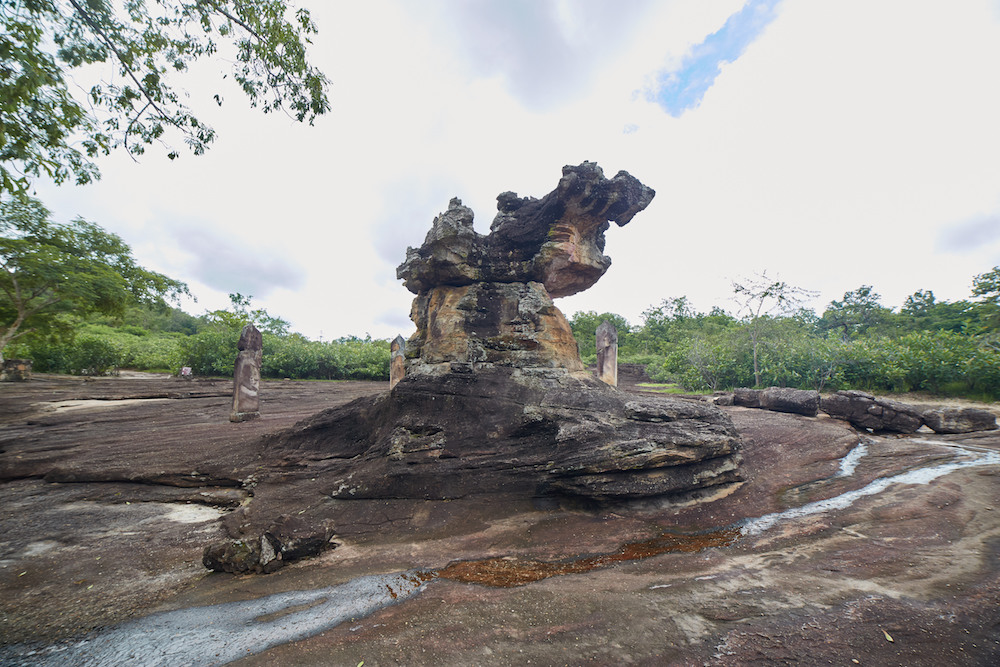
After the Mon, the Khmer also left their mark on the area. The Tham Phra carving of Buddha is one of the most famous sites at Phu Phra Bat. Like many of the significant Khmer temples at Angkor, the rocks in the area are composed of sandstone.
Hiking up the trail at the northern tip of the park, I came to a cliff overlooking the Isaan countryside and the Laotian mountains in the distance. The name of this area is Pha Sa Dej, and from over 300 meters high, the views are stunning. According to an informational sign, this is also supposed to be where Tao Baros dropped the king’s head after the execution!
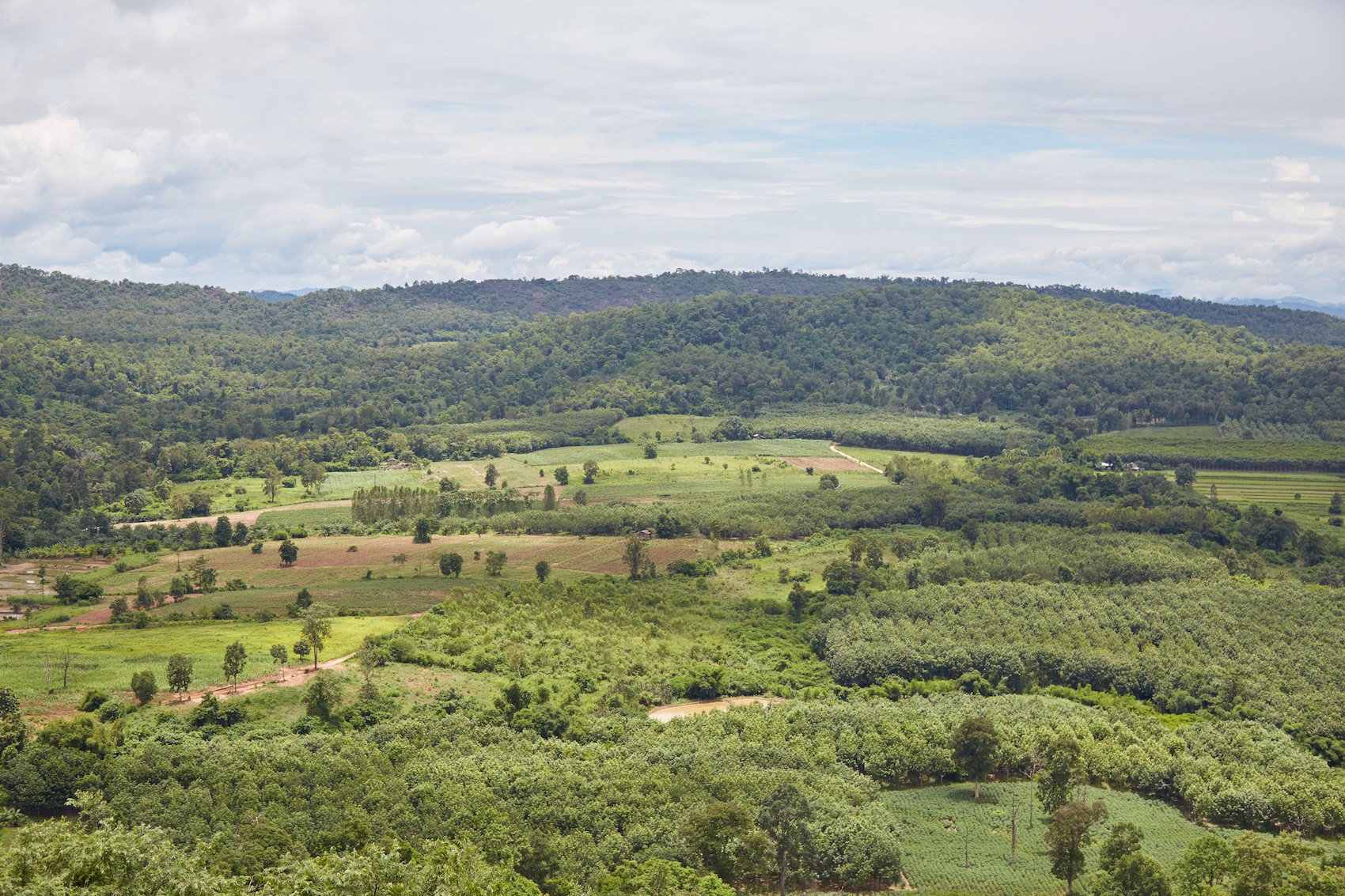
Finally, it was time to make my way to the oldest markings left by man at Phu Phra Bat Historical Park. The cave known as Tham Khom features a painting that’s estimated to be 3,000 years old. The painting is of seven red humans, all aligned in the same direction. Nearby is Tham Wua, the ‘Bullocks Cave.’ The animal paintings here are much more faint, but are also attributed to a group of people who lived in the area thousands of years prior.
Everyone from prehistoric cavemen to hermits to powerful empires left their mark in some shape or form on Phu Phra Bat. But none of the paintings or man-made constructions can compete with what was left there by nature. As I contemplated the powerful forces of wind and water that helped form these mushroom-shaped rocks over time, I noticed the sound of thunder rumbling in the distance.
It was time to go. Heading back to the entrance, I made a stop at the luxurious restroom before tracking down my driver in the parking lot. Only a few hours had passed, but it felt like much longer.
'But none of the paintings or man-made constructions can compete with what was left there by nature.'
- Mueang Phan, Ban Phue District, Udon Thani
- 8:00 - 18:00
- Every day
- 100 baht
Additional Info
When entering the park, you’ll be given a map of the area. There’s also excellent signage, so you shouldn’t have a hard time finding all the main sites. You won’t come across everything from the legend of Nang Usa in the order they appear of the story, and you’ll likely find the temple of Tao Baros first. Also keep in mind that the English spelling is somewhat inconsistent between the map and informational signs.
You should be able to see everything in the main park area in two or three hours. Separate from the main park area is a temple built around the footprints of the Buddha, after which the site was named. However, it’s not walkable from the park and I didn’t end up seeing it myself.
From Nong Khai: To get to Phu Phra Bat Historical Park from Nong Khai, first make your way to the central bus station. You won’t be able to get all the way to the park from here, but your destination should be the town of Ban Phu in Udon Thani province. From Nong Khai to Ban Phu it should take around 90 minutes one-way.
You won’t be taking a typical bus but a shared red songthaew that costs 55 baht. The departure times from Nong Khai are at 7am, 9am and 11am. I took the 9am one, which was fine for getting to the park, seeing everything and getting back the same day.
Very few people visit Phu Phra Bat, and if you mention anything about Udon Thani province to the staff at the bus station, they’ll likely assume you want to go to Udon Thani city or the airport. In my case, despite telling them ‘Ban Phu’ and showing them the location on Google Maps, I was still led to a minivan destined for the airport. Then I showed the location again to the driver who told me I was on the wrong bus, and he finally directed me to the correct songthaew.
On the way to Ban Phu you’ll stop in one other town called Thabo, but make sure to stay on until you get to Ban Phu. I assume the songthaew takes you all the way to Ban Phu’s central bus station, but in my case, I got off a little too early.
We stopped at what looked like a bus station at first, as it was a large covered concrete area with lots of cars. I followed a Thai couple off the songthaew but then realized that all the other passengers had stayed on as the vehicle drove away.
It was actually some large market/parking lot hybrid that I got off at by mistake, but at least I was in the right town. This wasn’t a big deal because I just wanted to take a tuk tuk to the park, and finding a driver was easy. The problem was, though, that I didn’t know the timetable for the songthaews back to Nong Khai. Fortunately, in the end this didn’t turn out to be a problem after all.
I met some drivers on a corner near a shopping mall, and we negotiated a round-trip price (300 baht) for one of them to take me to Phu Phra Bat Historical Park and then back to town again. Keep in mind that some Thai drivers often reverse the meanings of ‘one-way’ and ’round-trip’ when speaking English.
I also explained to the drivers that I wanted to return to Nong Khai (via songthaew) after the park and they understood what I wanted. After I was done at the park and the driver brought me back to the same spot in Ban Phu where I met him, he told me to wait for awhile for a songthaew to come.
Even though this was a random side street, the songthaew did indeed come and parked there until its scheduled departure time of 15:15. If you get off at the proper bus station in Ban Phu, you won’t have to deal with waiting in random side streets like I did, of course.
From Udon Thani: From Udon Thani city you also want to get to the town of Ban Phu, from where you’ll need to take a private taxi or tuk tuk. Supposedly there are hourly minibusses from Rangsina Market, with the last return minibus leaving at 18:00.
FROM WITHIN THAILAND:
There are plenty of options to getting to Nong Khai from all around Thailand, as it’s the main border town for those traveling overland to Laos. You can take a train directly from Bangkok (Hua Lamphong Station) which takes around 11 hours. You can also take a bus from Bangkok operated by the company Budsarakham Tour.
From Chiang Mai, there is one bus which goes directly to Nong Khai operated by the Sueksa Tour Company for around 900 baht.
However, the best way to reach Nong Khai from Bangkok, Chiang Mai, or anywhere else outside of the Isaan region is probably to fly. The nearest airport is Udon Thani, but you can find direct flights by Nok Air for as cheap as the bus or train tickets cost. From Udon Thani airport, you can take a minibus directly to Nong Khai for 200 baht.
FROM LAOS:
From Vientiane, simply go to the same bus station behind the Talat Sao Mall where you took the bus to get to Buddha Park. Don’t take the same bus, but look for a ticket window near the mall that has an English sign for bus tickets to Thailand. There are several leaving every day and they are very cheap, only costing around 15,000 kip.
These buses will take you across the bridge, wait for you to go through Thai immigration, and then take you all the way to the bus terminal in Nong Khai. Fortunately, the Nong Khai bus terminal is within walking distance from most of the area’s hotels and guest houses, so there shouldn’t be any need for a taxi ride.
Nong Khai has plenty of affordable accommodation right beside the Mekong. Though the town isn’t popular with regular tourists (a shame, really), plenty of people doing visa runs to Laos stay for a night or two, hence the abundance of hotel options.
I had a great experience at the Pan Guesthouse. I had a very spacious room with a private bathroom for 500 baht a night. While my room had no view, there was a communal balcony with great views of the Mekong – much nicer than any of the views from the Vientiane side! There were also tables and chairs set up if you want to relax outside during the sunset.

Pin It!



